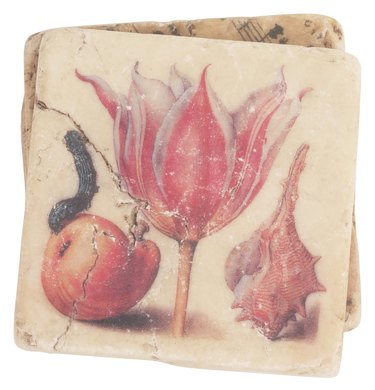
Painting ceramic tiles is a creative way to freshen a room without going through the cost and hassle of pulling up and replacing old tiles. There are several things, sealant included, that you should consider when painting tile. Among them are the type of paint and how you prepare the tile prior to painting.
Preparing the Tile
Video of the Day
Tile is a hard, relatively non-porous surface. Ensuring a successful painting job begins with preparing the tile. For paint to stick to the tile it needs to be clean. Any grease, dirt, dust or other grime between the tile and the paint will prevent it from sticking and cause peeling. Any cleaner will work -- you just need a brush and some elbow grease. You can use sandpaper to lightly abrade the tile and help the paint adhere to it; just ensure you remove all the tile dust prior to painting.
Video of the Day
Choosing Paint
Without the proper paint, a good sealer won't be able to do its job. If the paint underneath the sealer peels, so will the sealer you use. Oil-based paints work well for painting on ceramic tiles and are available online or at craft and art supply stores. Water-based paints with urethane in them are extremely sticky and adhere well to ceramic tiles. These are available at paint and hardware stores.
Sealant
Water-based polyurethane is the perfect sealant for painted tile. Polyurethane and urethane are the same thing, so you can look for products containing either one. Ensure the paint is thoroughly dry before applying the sealer. The harder the paint is, the better the polyurethane will work. If the paint isn't dry, the polyurethane could dissolve it and leave you with a sticky mess. Clean the tile prior to application and read the label of the polyurethane you buy to ensure there are no special application instructions. Use three or four coats for the best results.
Other Things to Consider
Painting tiles that frequently get wet will most likely not work. Water will soften and degrade the sealer and paint, making scratching inevitable. Avoid shower tile or any tile in unvented bathrooms. Also, consider using a spray-on polyuerethane. Using this method, you can avoid possibly damaging paint that isn't quite dry by using brushes and sealer on it. If possible, paint a test tile. Wait for it to dry and then use the polyurethane. This way you'll be able to see if the paint and the sealer you have will work together and how long you'll need to wait in between painting and sealing.